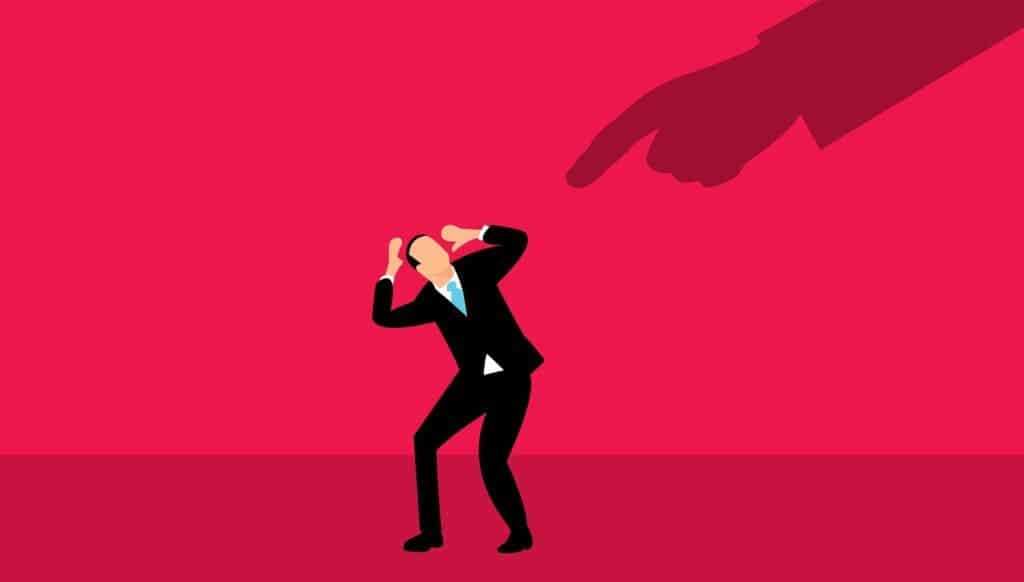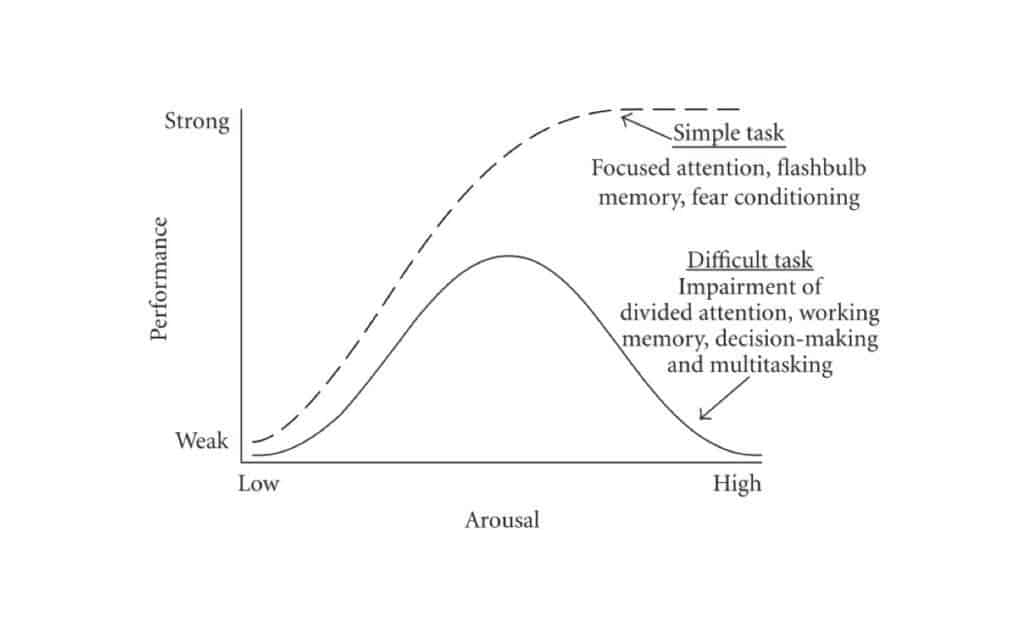Yerkes Dodson Yerkes Dodson Easy Hard Task
Ability is a curious thing. Even the most qualified among us have felt our skills magically drain away when someone is observing us intently, or feel our voice crack when we need to hold a speech. On the other hand, when something important to us is on the line, we can surprise even ourselves with how well we solve an issue.

Our capabilities and skills don't actually change dramatically from one moment to the next, so then, what causes these shifts in performance? One possible answer, proposed over one century ago by psychologists Robert M. Yerkes and John Dillingham Dodson, is an empirical 'law' that bears their name to this day.
It's not an actual law, like gravity or taxes, but observational data gathered since it was first formulated does support it. That's not to say that we've proven the Yerkes–Dodson law true, it's more that we haven't yet proven it to be untrue, but that's pretty par for the course when discussing psychology. Still, it's a very interesting topic, and one which is applicable to all of us, and often, throughout our lives.
So, without any ado, let's see how arousal and performance interplay during our lives.
The curve
Boiled down to the core, the Yerkes–Dodson law describes the effect different levels of arousal have on our performance. Arousal, in the psychological sense, is the state of your body being alert, activated, ready for action and reaction, or the process of it reaching that state.
The main takeaway from this law is that there is an ideal level of arousal for every task where our performance is maximized. At that point, we're not too aroused (stressed), which impairs our ability to function, nor are we too relaxed, which would keep us from engaging with the activity in the first place. Balance is the name of the game where performance is concerned.
The best way to understand the Yerkes–Dodson law, and the way it's generally presented, is in a graph. This graph is usually a single line following a bell curve: like a wave with its crest pointing upwards. The vertical axis (how high the line reaches) indicates performance, while the horizontal axis (left to right) indicates progressively higher levels of arousal.
While this isn't wrong, and is the most-often cited variation of the graph, it is incomplete. The full graph displays two lines. One represents the relationship between arousal and performance levels in complicated tasks, and the other for simple tasks. This is quite an important distinction to make, as we'll see going forward. The incomplete graph is often referred to as the Hebbian version of this law.

The highest point on each of these lines indicates the point at which an individual engaging in either of the two classes of tasks reaches maximum performance. For simple tasks, it tends to rise with arousal, and then plateau. For more complicated tasks, however, performance rises with arousal up until the middle point, after which any increases in arousal levels tend to impair our ability to function.
The duo based this graph on rat experiments they performed in the lab. During these tests, Yerkes and Dodson found that they could motivate the animals to navigate a maze by administering small electrical shocks to them. If these were too light for the rats to actually feel — i.e. the shocks didn't increase the animals' level of arousal — they wouldn't bother doing the thing at all. Up to a point, increasing the intensity of the shocks made the rats first engage with the task, and then go through the maze faster — in other words, it increased their performance steadily.
But if arousal is the state of being alert or ready to act and react, shouldn't more arousal mean more alertness and ability? Shouldn't both curves, then, look like the one for simple tasks? Well, it comes down to how alertness is mediated by our bodies and how it, in turn, impacts our bodies.
From apathy to stress
Arousal is a key regulator of our emotions, consciousness, and our ability to actually interact with and process sensory information coming from our environment. It is, in a very real sense, the only thing that allows you to do pretty much anything voluntarily, from getting out of bed in the morning to engaging in sexual activity.
But just like any good regulator, the key here is just how much arousal you're experiencing.
One of the easiest ways to help you understand the effect of arousal is through the difference between introverted and extroverted people — we've all met both kinds in our lives. According to one theory (Eysenck's theory of arousal), every individual's brain has a 'natural frequency', its own baseline level of activity, or stimulation. For introverted people, it holds, this baseline is higher in intensity than in the brains of extroverted individuals. Due to this difference, these two types will seek out environments that produce opposite effects for their arousal levels. Extroverts, who are naturally under-stimulated, seek situations and activities that actively increase their arousal. Introverts, who are naturally over-stimulated, will seek to avoid those same situations and seek low-arousal environments instead.
If you've ever talked with an extroverted friend that's been cut off from their supply of social stimulation for a while, you'll know just how desperate they are to get that chatting in with you; maybe even go out for lunch, for a concert, bungee-jumping! At the other end of the scale, you've probably also seen how overwhelmed an introvert close to you becomes after they've been forced into highly stimulating situations for far too long. With a tired look, and even a cranky demeanor, all they really want is to go home and not talk to anyone for a bit.
Both of these situations showcase how too little arousal or too much can impair our ability to perform. If we take "being an emotionally stable human" as the task, both the extrovert and the introvert do far worse in this scenario than they would in ideal conditions. At the same time, even an extrovert can become overwhelmed, and even introverts can become apathetic, which would also interfere with that task.
It's an imperfect analogy, but I feel it helps illustrate how too little or too muc arousal can be detrimental to our performance for complicated tasks. Another great example is found in the low arousal theory. According to it, attention deficit hyperactivity disorder (ADHD) and antisocial personality disorders could be the result of abnormally low baseline levels of arousal in the brain. The effects we can perceive outwardly — difficulty holding focus, compulsive hyperactive behavior, and a propensity for seeking novelty — would, according to this theory, be an effort by the individual to increase their arousal through external stimuli.
So why don't simple tasks follow the same response pattern to arousal? One framework that attempts to explain this difference is the cue utilization theory. This theory holds that as the internal level of arousal of a person increases, their attention starts becoming narrower. Their brain automatically works to remove irrelevant information (such as environmental cues) from the individual's conscious perception to help them better focus on the task at hand. If arousal is too low, too much information is allowed past the filter, so we can't focus. If arousal levels are too high, too little information makes it through, so again, we can't perform adequately.
Arousal doesn't influence simple tasks in the same way it does complicated ones for the simple reason that simple tasks are simple. They require much less conscious input from you, and they take much less of your higher executive abilities (such as deduction, problem-solving, or memory) to complete. Drinking water is much easier than calculus — hence, you can drink water adequately even if you're unbelievably stressed.
You might be surprised by my use of the term 'stressed' here. The concepts of arousal and stress are actually very closely linked. What we usually tend to refer to as 'being stressed' is a long-term buildup of arousal combined with a lack of an adequate way to release it. Stress, then, forms when your body prepares you to deal with a task such as a perceived threat but it either is so far outside your abilities that it becomes overwhelming, or there simply is no way to address the issue (such as being broke with no income source lined up).
Should you abuse it?
On a personal level, understanding the rough mechanisms highlighted by the Yerkes-Dodson law can be beneficial. Artificially increasing our arousal can spur us to action if we're being lazy with a task we need to do. Intentionally keeping our arousal under tabs through relaxation exercises can keep us functioning in high-stress situations when our peers start to crack. But it can only help you along, it won't do the thing for you.
Let's circle back to what we were discussing in the beginning. Despite calling it a law, the Yerkes-Dodson law is not a law. The authors themselves never offered it as, nor meant it to be viewed as, an absolute truth regarding animal behavior; they simply zapped some rats and put the results in a pretty chart. It gives us a glimpse into a mechanism that is true, but doesn't aim to show us the whole picture.
If you're drunker than a sailor, no level of arousal, by itself, is enough to make you drive safely. No amount of arousal will make a malnourished person able to sustain heavy physical activity. Our emotions, belief systems, the cultural landscape we were raised in, our skills and socioeconomic status — these and many others factor into our ability to perform any task, and even our desire to engage productively with tasks in the first place.
The Yerkes-Dodson law is a hotly debated topic in psychology to this day. Perhaps, more than anything else, because it enjoys traction with everyday people and quite a bit of popularity. Still, studies such as this one — which reports that "practitioners should not seek to increase performance through the manipulation of employee stress levels" — have repeatedly highlighted that the law doesn't translate directly into practice.
Psychology is a complicated field of research, and human psychology likely takes the cake. Understanding that stress has an impact on our performance, and how that relationship looks, can help us achieve success in our own lives. But it's not the only factor influencing our abilities, or our success. So be mindful of it in your day to day, but please don't try to stress others around you in an effort to make them more productive. You'll just end up without any friends.
Source: https://www.zmescience.com/science/yerkes-dodson-law-psychology-feature/